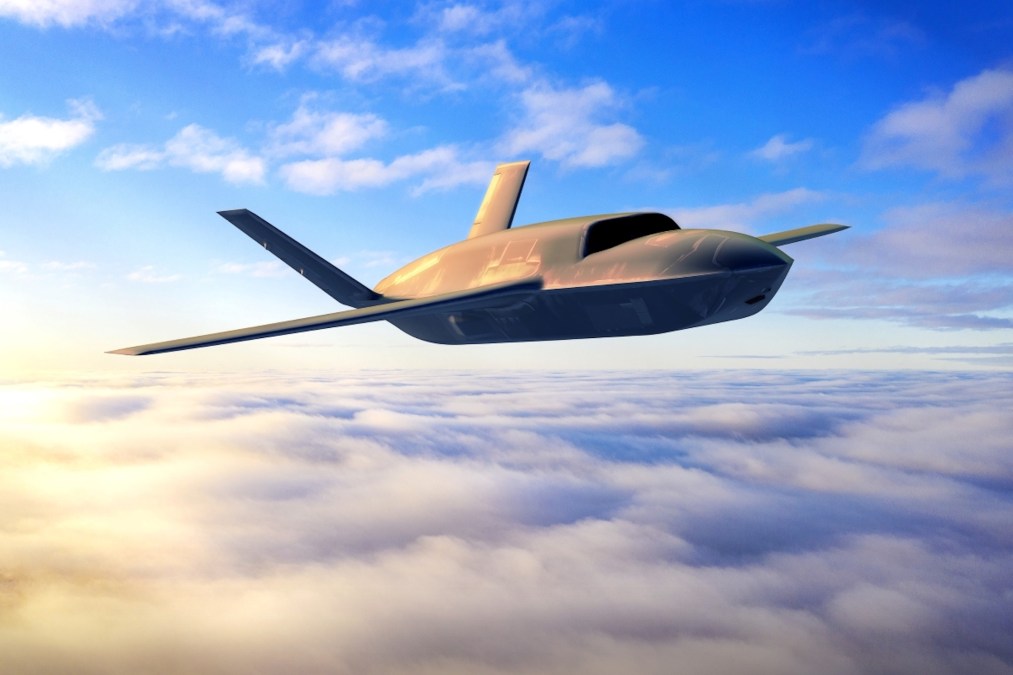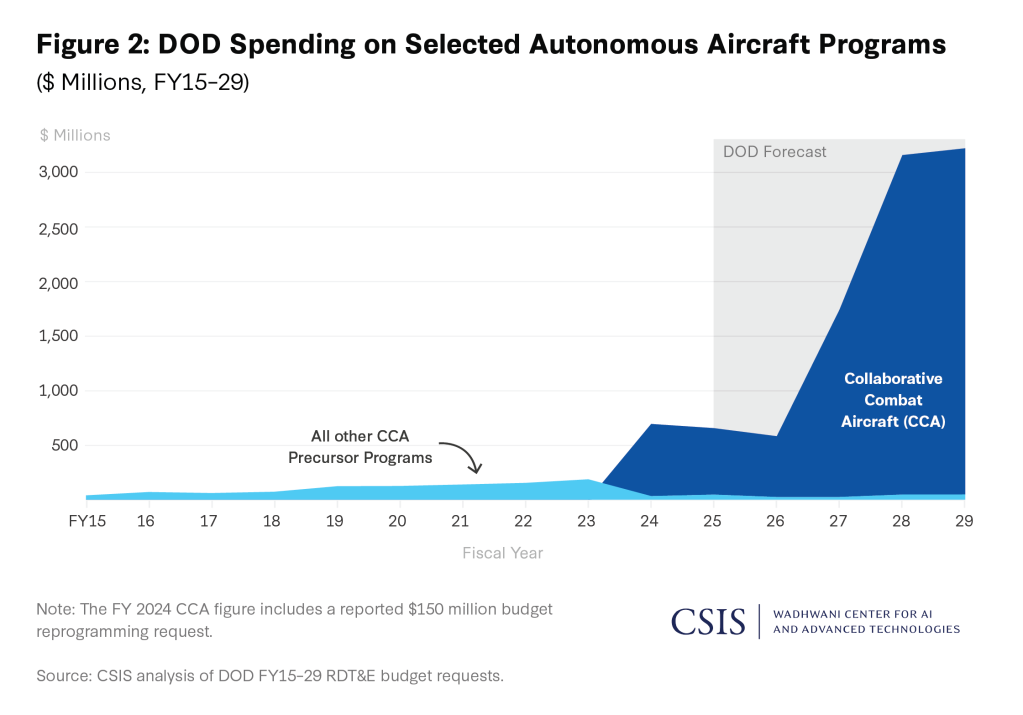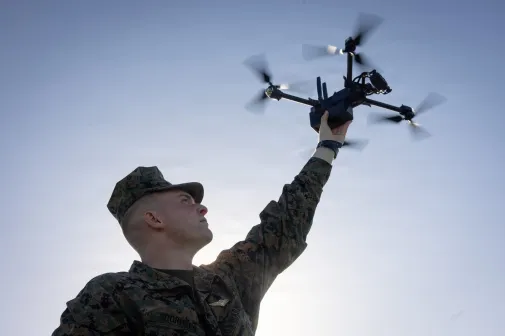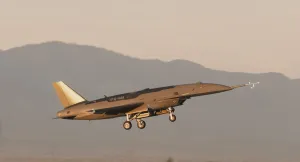Report: Air Force CCA program still faces cost, bureaucratic hurdles despite positive movement

As the Air Force continues to prioritize development of its collaborative combat aircraft (CCA) initiative, there are still a number of potential obstacles related to the service’s history in developing new platforms that it must address for the program to be considered successful, according to a new report from the Center for Strategic and International Studies.
Part of the service’s Next Generation Air Dominance (NGAD) family of systems, the CCA drones are intended to fly alongside the Air Force’s fifth- and sixth-generation platforms and augment its manned aircraft fleet. The goal is to develop a system that is a fraction of the cost of crewed platforms and can be quickly built in large quantities on flexible timelines.
The service awarded Anduril and General Atomics contracts in April to develop the air vehicles for the first operational systems known as Increment 1, and it’s concurrently developing requirements for the follow-on Increment 2 platforms. Meanwhile, the Air Force is also working with five vendors on a separate contract to develop the mission autonomy for CCAs.
And while the program is moving forward, a report published by CSIS on Tuesday highlighted that the service’s existing acquisition culture could still turn the CCA drones into platforms that are too expensive and exquisite to produce, potentially inhibiting the Air Force’s ability to field the systems in a meaningful number before the end of the decade.
“Over the next few years, Air Force program managers will encounter lots of tempting opportunities — and perhaps even pressure from Congress — to make the CCA design slightly better performing for (supposedly) slightly more money and a slightly slower schedule,” noted the report — titled “The Defense Department’s Collaborative Combat Aircraft Program: Good News, Bad News, and Unanswered Questions.”
Greg Allen, director of CSIS’s Wadhwani Center for AI and Advanced Technologies and co-author of the report, said that although uncrewed aircraft can have a lower price tag than manned aircraft — due to them carrying less equipment — adding exquisite sensors and having low production capacities may crank up the price of some drones — such as the RQ-4 Global Hawk, which can cost $130 million or more per unit.
Air Force Secretary Frank Kendall has previously estimated the unit cost for CCAs will be around $25-30 million, with the intent to field at least 1,000 platforms. While that is about one-third of the cost of an F-35 Lightning II fighter jet, it is also near the price point for F-16 Falcons currently sold to U.S. allies and partners, according to the report.
“What U.S. strategy needs are assets that it can comfortably put at risk for the mission. And exquisite, expensive stuff is really difficult to risk,” Allen told DefenseScoop ahead of the report’s publication. “So the question here is, are we really thinking about the optimal design space in terms of the tradeoff between cost and performance?”
CCAs are expected to have a modular design that allows them to perform a range of functions, including offensive strike, electronic warfare and intelligence, surveillance and reconnaissance (ISR). Even though those mission sets will require additional equipment, Air Force leadership have publicly asserted they are trying to prevent unnecessary cost growth stemming from additional requirements.
“The Air Force already has expensive, high-performing fighter aircraft like the F-35. The point of the CCA is to be cheap, rapidly built, and numerous,” the CSIS report stated. “This is not to say that the Air Force should tolerate lousy work on the part of its industry partners but merely that cost and schedule must always be kept firmly in focus.”
At the same time, Allen noted that current conversations around the price tag for CCA and other programs focus on sacrificing capability to produce cheaper platforms. The report highlights that cost models commonly used by the Air Force and other government organizations often don’t account for alternative pathways or innovative production methods that can improve cost efficiency without jeopardizing performance and schedule.
For example, early assessments by NASA and the Air Force found that SpaceX’s Falcon 9 rocket development would cost nearly $4 billion to build. In reality, a subsequent NASA review determined the Falcon 9’s development cost was just $400 million.
“I think there’s also just a lot of slack in the defense industrial base, and an opportunity to improve costs there,” Allen said. “The strong existence proof there is SpaceX, which showed up and started with a very modest capability at a very cheap price, and then delivered a pretty exceptional capability still at a very cheap price.”
The CSIS reports cautions that the Air Force’s cost modeling for its fighter aircraft could become complacent, as well. It urges the service to not concede to a CCA price tag of $25 million or more before considering new approaches to reduce the program’s cost.
One concern could be relying too much on military-specific equipment that can only be produced by a small number of companies, Allen said. Waiting on long-lead items to deliver for months or even years could create delays in CCA deployment.
“A ramification of that is a lot of aircraft sitting in the factory 95 percent finished and unable to fly because of that lingering 5 percent, which would be a really, really lousy outcome,” he said.
Despite the potential for future delays and cost growth, the report largely praised the Air Force’s work on CCAs — emphasizing that it is the first real program of record at the Defense Department for an autonomous system. The Air Force is also devoting time to additional questions related to operational doctrine, infrastructure, training and lifecycle sustainment through an Experimental Operations Unit for the program, the document noted.
The service’s budget for the program is another key indicator that CCAs can move out of the “science project territory” that many new capabilities get stuck in and become an actual operational system, the report stated. According to its budget request for fiscal 2025, the Air Force plans to spend more than $6 billion on the CCA program and related projects over the next five years.

The report also points to the service’s acquisition approach — specifically its decision to give industry less stringent requirements to promote innovative designs, as well as the choice to divide the contracts into one lane focused on hardware and another on software.
Even though it might not work for every brand new capability, the approach is appropriate for CCAs given the current state of the defense technology industrial base, Allen said.
“You’ve got a really weak competitive landscape, just in terms of there either being a monopoly or a near monopoly,” he said. “The hardware side of that equation has really high upfront investment costs … If you’re trying to improve the competitive landscape in the DOD, software is a really nice starting point because, while it is expensive, the upfront costs are much lower so it’s easier to encourage new entrants into the ecosystem.”
In addition, the authors noted the importance of the Air Force’s Autonomy-Government Reference Architecture (A-GRA) in creating standards for vendors writing software and adding new capabilities, as well as ensuring CCAs will be interoperable with other platforms across the Defense Department.
The report emphasized the importance of the award to Anduril, a nontraditional contractor backed by venture capital. The contract serves as a positive signal to those who may be considering investments in companies developing capabilities for the Pentagon, which could give a boost to the overall defense tech ecosystem, Allen said.
There are still some unanswered questions related to CCAs, such as whether they should be classified as an autonomous weapon system. It’s also unknown if the cutting-edge platforms will be enough to deter or defeat China’s growing military technology strength.
Nevertheless, Allen said he believes the success or failure of the program will influence other autonomous system efforts across the Defense Department.
“The fact that we’ve got a flagship program of record in a military service — and with an approach that other services appear ready to emulate — I think this is the turning point in the entire DOD for autonomy,” Allen said. “If this program goes well, I think that will be an accelerated turning point. And if this program encounters a lot of trouble, I think the overall shift will also encounter a lot of trouble.”






